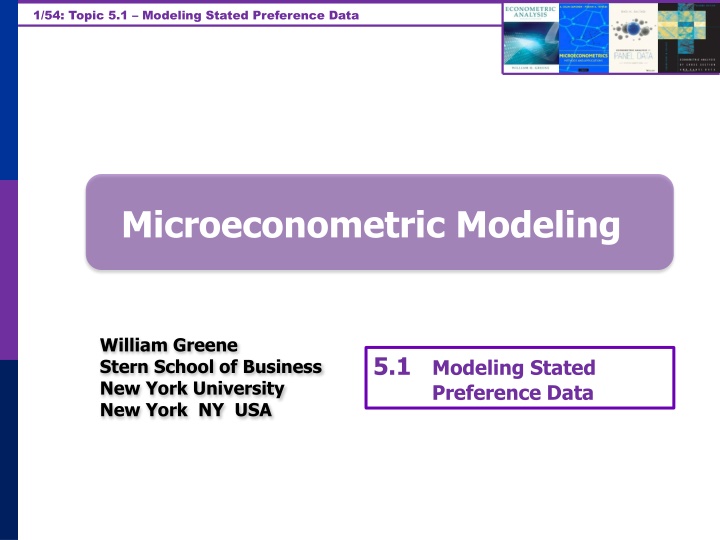
Stated Preference Data Modeling in Microeconometrics
Explore the modeling of stated preference data in microeconometrics with concepts like revealed preference, attribute space, choice experiments, and more. Understand the advantages and disadvantages of revealed and stated preference data, strategies for analyzing such data, and an application example in shoe brand choice. Dive into the complexities and considerations of analyzing simulated data with latent class processes.
Download Presentation

Please find below an Image/Link to download the presentation.
The content on the website is provided AS IS for your information and personal use only. It may not be sold, licensed, or shared on other websites without obtaining consent from the author. If you encounter any issues during the download, it is possible that the publisher has removed the file from their server.
You are allowed to download the files provided on this website for personal or commercial use, subject to the condition that they are used lawfully. All files are the property of their respective owners.
The content on the website is provided AS IS for your information and personal use only. It may not be sold, licensed, or shared on other websites without obtaining consent from the author.
E N D
Presentation Transcript
1/54: Topic 5.1 Modeling Stated Preference Data Microeconometric Modeling William Greene Stern School of Business New York University New York NY USA 5.1 Modeling Stated Preference Data
2/54: Topic 5.1 Modeling Stated Preference Data Concepts Models Revealed Preference Stated Preference Attribute Nonattendance Random Utility Attribute Space Experimental Design Choice Experiment Environmental Attitude Multinomial Logit Model Latent Class MNL Nested Logit Mixed Logit Error Components Logit
3/54: Topic 5.1 Modeling Stated Preference Data Revealed Preference Data Advantage: Actual observations on actual behavior Market (ex-post, e.g., supermarket scanner data) Individual observations Disadvantage: Limited range of choice sets and attributes does not allow analysis of switching behavior.
4/54: Topic 5.1 Modeling Stated Preference Data Stated Preference Data Purely hypothetical does the subject take it seriously? No necessary anchor to real market situations Vast heterogeneity across individuals E.g., contingent valuation
5/54: Topic 5.1 Modeling Stated Preference Data Strategy Repeated choice situations to explore the attribute space Typically combined RP/SP constructions Mixed data Expanded choice sets Accommodating panel data Multinomial Probit [marginal, impractical] Latent Class Mixed Logit
6/54: Topic 5.1 Modeling Stated Preference Data Application: Shoe Brand Choice Simulated Data: Stated Choice, 400 respondents, 8 choice situations, 3,200 observations 3 choice/attributes + NONE Fashion = High / Low Quality = High / Low Price = 25/50/75,100 coded 1,2,3,4 Heterogeneity: Sex (Male=1), Age (<25, 25-39, 40+) Underlying data generated by a 3 class latent class process (100, 200, 100 in classes)
7/54: Topic 5.1 Modeling Stated Preference Data Stated Choice Experiment: Unlabeled Alternatives, One Observation t=1 t=2 t=3 t=4 t=5 t=6 t=7 t=8
8/54: Topic 5.1 Modeling Stated Preference Data Application: Pregnancy Care Guidelines
9/54: Topic 5.1 Modeling Stated Preference Data Application: Travel Mode Survey sample of 2,688 trips, 2 or 4 choices per situation Sample consists of 672 individuals Choice based sample Revealed/Stated choice experiment: Revealed: Drive,ShortRail,Bus,Train Hypothetical: Drive,ShortRail,Bus,Train,LightRail,ExpressBus Attributes: Cost Fuel or fare Transit time Parking cost Access and Egress time
10/54: Topic 5.1 Modeling Stated Preference Data Customers Choice of Energy Supplier California, Stated Preference Survey 361 customers presented with 8-12 choice situations each Supplier attributes: Fixed price: cents per kWh Length of contract Local utility Well-known company Time-of-day rates (11 in day, 5 at night) Seasonal rates (10 in summer, 8 in winter, 6 in spring/fall)
11/54: Topic 5.1 Modeling Stated Preference Data Combining RP and SP Data Sets - 1 Enrich the attribute set by replicating choices E.g.: RP: Bus,Car,Train (actual) SP: Bus(1),Car(1),Train(1) Bus(2),Car(2),Train(2), How to combine?
12/54: Topic 5.1 Modeling Stated Preference Data Each person makes four choices from a choice set that includes either two or four alternatives. The first choice is the RP between two of the RP alternatives The second-fourth are the SP among four of the six SP alternatives. There are ten alternatives in total.
13/54: Topic 5.1 Modeling Stated Preference Data An Underlying Random Utility Model
14/54: Topic 5.1 Modeling Stated Preference Data Nested Logit Approach Mode RP Car Train Bus SPCar SPTrain SPBus Use a two level nested model, and constrain three SP IV parameters to be equal.
15/54: Topic 5.1 Modeling Stated Preference Data Enriched Data Set Vehicle Choice Choosing between Conventional, Electric and LPG/CNG Vehicles in Single-Vehicle Households David A. Hensher William H. Greene Institute of Transport Studies Department of Economics School of Business Stern School of Business The University of Sydney New York University NSW 2006 Australia New York USA Conventional, Electric, Alternative 1,400 Sydney Households Automobile choice survey RP + 3 SP fuel classes Nested logit 2 level approach to handle the scaling issue
16/54: Topic 5.1 Modeling Stated Preference Data Attribute Space: Conventional
17/54: Topic 5.1 Modeling Stated Preference Data Attribute Space: Electric
18/54: Topic 5.1 Modeling Stated Preference Data Attribute Space: Alternative
19/54: Topic 5.1 Modeling Stated Preference Data Experimental Design
20/54: Topic 5.1 Modeling Stated Preference Data Willingness to Pay for Green Energy
27/54: Topic 5.1 Modeling Stated Preference Data Stated Choice Experiment: Travel Mode by Sydney Commuters
28/54: Topic 5.1 Modeling Stated Preference Data Would You Use a New Mode?
29/54: Topic 5.1 Modeling Stated Preference Data Value of Travel Time Saved
